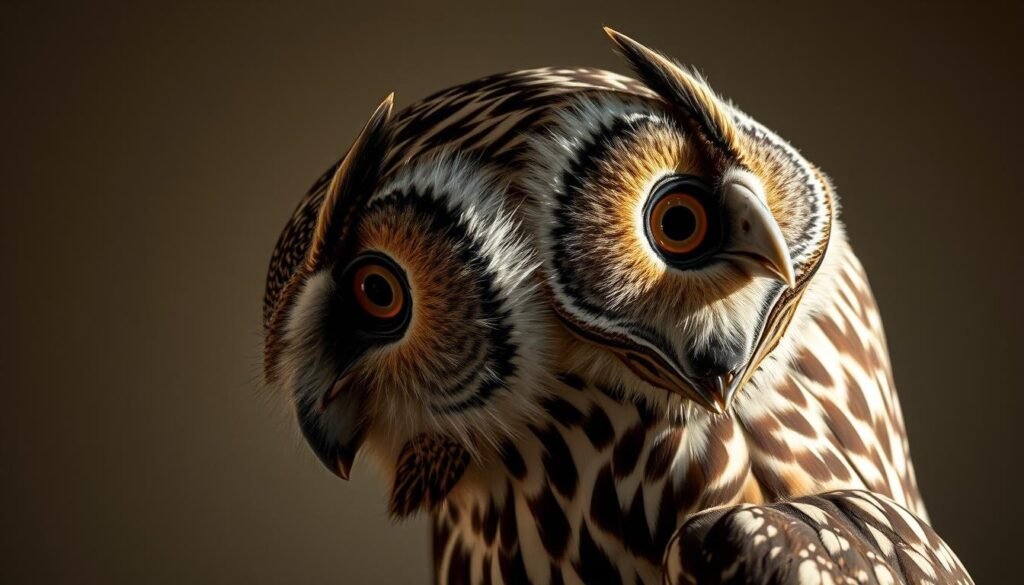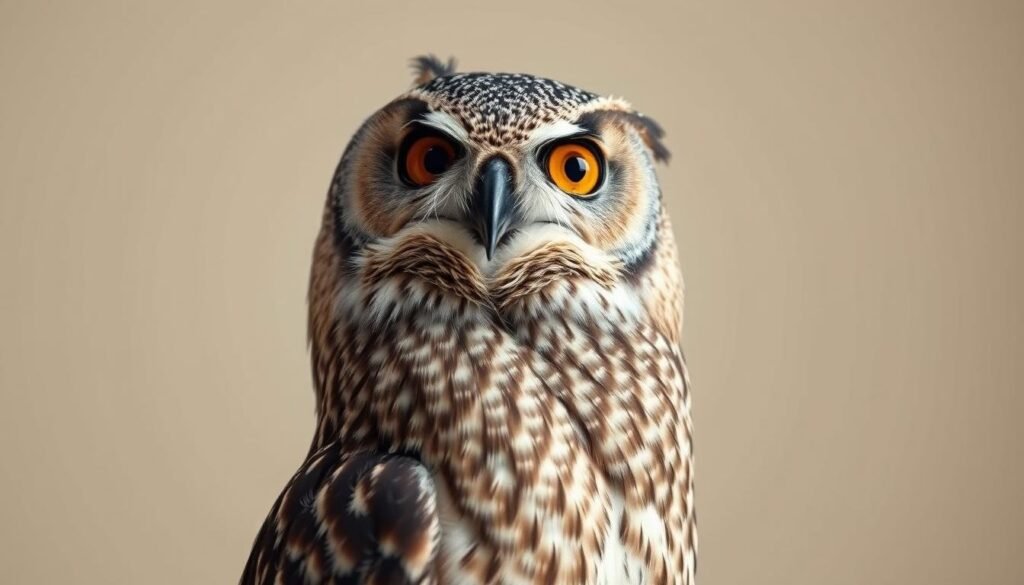Owls Rotate Their Heads Almost Fully: Have you ever wondered how nocturnal hunters can turn their heads so far? This amazing ability is a key part of their anatomy. It helps them hunt better.
Learning about these birds, you’ll see their night vision and silent flight are impressive. But their head rotation mechanism is even more amazing. It lets them look around without moving their whole body. This is both fascinating and very useful.
Discovering the science behind this ability can teach us about their hunting skills. It shows how they’ve adapted to be such great predators. [Owls Rotate Their Heads Almost Fully]
Contents
- 1 The Remarkable Head Rotation of Owls
- 2 Why Do Owls Rotate Their Heads Almost Fully?
- 3 The Unique Anatomy That Makes It Possible
- 4 Scientific Research and Discoveries
- 5 Comparing Owl Neck Rotation to Human Limitations
- 6 Evolutionary Advantages and Adaptations
- 7 Conclusion: Owls Rotate Their Heads Almost Fully?
- 8 FAQ
- 8.1 How far can owls rotate their heads?
- 8.2 What makes owls’ head rotation possible?
- 8.3 Why is head rotation important for owls?
- 8.4 How do owls prevent blood from pooling in their heads when they rotate them?
- 8.5 What can we learn from the anatomy of owls’ necks?
- 8.6 How does owl neck rotation compare to human neck rotation?
- 8.7 What are the evolutionary advantages of owls’ head rotation?
- 8.8 What have scientific studies revealed about owls’ head rotation?
The Remarkable Head Rotation of Owls
Owls can turn their heads almost fully around, which is quite amazing. This ability lets them see in multiple directions without moving their whole body. It makes them very good hunters. Their head rotation is thanks to their unique anatomy, including special bones and muscles.
Owls have 14 cervical vertebrae, twice as many as humans. Their muscles and tendons also help with this impressive head turn. This neck flexibility is key for their hunting success, helping them spot prey from different angles.
The owl neck flexibility comes from their special body design for hunting at night. This, along with their sharp vision, makes owls top predators in the animal world. [Owls Rotate Their Heads Almost Fully]
Why Do Owls Rotate Their Heads Almost Fully?
Have you ever wondered why owls can turn their heads almost all the way around? This amazing ability gives them big evolutionary advantages, especially as nocturnal hunters. It lets them look around without moving their whole body, making them sneakier and better at catching prey.
Owls turn their heads to improve their vision and hearing. Since they hunt at night, these senses are key to finding food in the dark. By moving their heads, they can find sounds and see prey more easily.
| Advantages | Description |
|---|---|
| Stealth | Rotating their heads allows owls to remain still, making them less detectable to prey. |
| Wide Field of Vision | Owls can see in multiple directions without moving their entire body. |
| Enhanced Hearing | By turning their heads, owls can better locate the source of sounds. |
The ability to rotate their heads is a big plus for owls living at night. This skill has helped them survive and thrive in their world. It’s a key part of how owls hunt.
The Unique Anatomy That Makes It Possible
Owls can rotate their heads thanks to their special body parts. They have blood vessels and mechanisms to prevent blood pooling. These features help owls move their heads without harming their brains.
Blood Pooling Prevention Mechanisms
Owls need to stop blood from pooling when they turn their heads. They have special blood vessels for a constant blood flow. This keeps their brain supplied with oxygen and nutrients.
Owls have a complex blood vessel system. It adjusts to their head’s rotation. This system keeps blood flowing, even when their heads are turned far.
| Anatomical Feature | Description | Function |
|---|---|---|
| Specialized Blood Vessels | Adapted to prevent blood pooling | Maintain blood flow during head rotation |
| Vertebral Artery Adaptations | Modified to accommodate head rotation | Ensure constant oxygen and nutrient supply |
Vertebral Artery Adaptations
The vertebral artery is key for blood to the brain. In owls, it’s changed to fit their head rotation. This keeps oxygen and nutrients flowing to the brain.
Owls’ unique body parts show their amazing adaptability. By studying these features, we learn how owls survive and thrive in their world. [Owls Rotate Their Heads Almost Fully]
Scientific Research and Discoveries
Scientists have studied owls’ head rotation to understand how they do it. Owls have a special neck structure. This includes bones, muscles, and blood vessels that work together.
Owls have 14 cervical vertebrae, which is twice as many as humans. This extra flexibility lets them move their heads more. The owl’s skeletal system is specially adapted to enable their impressive head rotation.
| Anatomical Feature | Description | Function |
|---|---|---|
| Cervical Vertebrae | 14 vertebrae in the neck | Allows for greater flexibility and range of motion |
| Muscles and Tendons | Specialized muscles and tendons | Facilitates head rotation and stabilizes the neck |
| Blood Vessels | Adapted blood vessels | Ensures continuous blood flow during head rotation |
Research has also looked into how owls’ heads rotate. Their visual system is connected to their head rotation. This helps them hunt well in the dark.
Comparing Owl Neck Rotation to Human Limitations
Owls have a neck that can rotate in amazing ways. This is quite different from humans. Owls can turn their heads much more than we can.
Humans can turn their heads about 70 to 90 degrees. But, owls can turn their heads up to 270 degrees or more. This is because of their special bones and muscles.
| Characteristics | Owls | Humans |
|---|---|---|
| Neck Rotation | Up to 270 degrees or more | 70 to 90 degrees |
| Vertebrae Structure | Specialized vertebrae allowing greater flexibility | Standard human vertebrae with limited flexibility |
| Muscle Structure | Powerful neck muscles for enhanced rotation | Less powerful muscles, limiting rotation |
By understanding these differences, we can see how special owls are. Their ability to rotate their heads is key to their hunting success.
Evolutionary Advantages and Adaptations
Owls are expert hunters at night. They can turn their heads a lot. This helps them look around without moving their whole body. It makes them quiet and saves energy.
This special ability has many benefits. It helps them find food in the dark. It also lets them keep an eye out for dangers. This way, they stay safe. [Owls Rotate Their Heads Almost Fully]

Their bodies are made for this head movement. They have strong neck bones and muscles. They also have more neck vertebrae than other birds. These features show how owls are perfectly designed for their life.
Learning about owls’ unique abilities shows how amazing they are. It shows how their body, behavior, and environment work together.
Conclusion: Owls Rotate Their Heads Almost Fully?
Owls have a special way of moving their heads. This lets them see in the dark, which is key for hunting at night. Their heads can turn almost all the way around, showing how well nature designed them.
Learning about owls’ head movement helps us appreciate these amazing birds more. Their unique body shape is a result of evolution. It helps them be great hunters in the dark.
Owls are perfectly made for hunting in the dark. Their design makes them very good at it. As we learn more about them, we can admire the clever ways they survive.
See Also: Why Do Elephants Flap Their Ears Constantly?
FAQ
How far can owls rotate their heads?
Owls can rotate their heads up to 270 degrees. This is much more than humans can do.
What makes owls’ head rotation possible?
Owls have a special skeletal and muscular setup. They have 14 cervical vertebrae. This lets them rotate their heads so far.
Why is head rotation important for owls?
It helps owls look around without moving. This makes them stealthier and better at hunting at night. [Owls Rotate Their Heads Almost Fully]
How do owls prevent blood from pooling in their heads when they rotate them?
Owls have special blood vessels. These ensure their brains get enough oxygen and nutrients, even when their heads are turned.
What can we learn from the anatomy of owls’ necks?
Owls’ necks are built for flexibility. Their bones, muscles, and blood vessels work together. This shows how they can rotate their heads so far.
How does owl neck rotation compare to human neck rotation?
Owls can rotate their heads much further than humans. This shows the big difference in their anatomy.
What are the evolutionary advantages of owls’ head rotation?
Owls’ ability to rotate their heads almost fully is a big advantage. It helps them be better hunters at night.
What have scientific studies revealed about owls’ head rotation?
Studies have shown how owls’ necks are made for rotation. They have special bones, muscles, and blood vessels. This helps us understand their amazing ability.

Zyair Larson, based in Denver, Colorado, has over 12 years of experience studying animal behavior. He has worked with the World Wildlife Fund (WWF) and National Geographic, researching wildlife and sharing insights on animal habits globally.

